Optimising Potato (Solanum tuberosum L.) Cultivation by Selection of Proper Soils
Abstract
1. Introduction
2. Materials and Methods
- unsuitable soils: 25 points and less
- suitable soils: 26–50 points
- less suitable soils: 51–75 points
- very suitable soils: More than 75 points.
3. Results and Discussion
3.1. Characteristics of Rural Areas with Regard to Potato Cultivation Suitability
3.1.1. Region of Very Suitable Soils
3.1.2. Region of Suitable Soils
3.1.3. Region of Less Suitable Soils
3.1.4. Region of Unsuitable Soils
3.2. Distribution of Potato Cultivation at Present Time
4. Conclusions
- in Slovakia, more than 30 thousand hectares are very suitable for potato cultivation. Rapid reduction in the area of this crop in recent years allows their cultivation in good conditions,
- in spite of the above, almost 42% of the potato areas are located in unsuitable territories for this crop (high slope, high gravel content and threat of water erosion),
- soils with point values more than 48 points are economically profitable for potato cultivation,
- categorising the suitability of soils for potato cultivation (developed maps and databases) will allow more efficient site selection.
Author Contributions
Funding
Acknowledgments
Conflicts of Interest
References
- FAO. 2018 International Year of Potato. Available online: http://www.fao.org/potato-2008/en/potato/cultivation.html (accessed on 30 March 2017).
- Deguchi, T.; Iwama, K.; Haverkort, A.J. Actual and Potential Yield Levels of Potato in Different Production Systems of Japan. Potato Res. 2016, 59, 207–225. [Google Scholar] [CrossRef]
- Vilček, J.; Bedrna, Z. The Suitability of Agricultural Soils and Landscape in Slovakia for Plant Cultivation; VÚPOP: Bratislava, Slovakia, 2007. (In Slovak) [Google Scholar]
- Nagyová, Ľ.; Dobák, D. A comparison of chosen potato indicators with Eastern and Central Europe countries and the EU. Acta Oecon. Inform. 2004, 1, 8–13. [Google Scholar]
- Jamborová, M. Potato–Situation and Outlook as of June 30, 2018; NPPC VÚEPP: Bratislava, Slovakia, 2018. (In Slovak) [Google Scholar]
- Statistical Office of the Slovak Republic. Consumption of Plant Protection Agents. 2018. Available online: http://datacube.statistics.sk/#!/view/en/VBD_SLOVSTAT/pl2022rs/Consumption%20of%20plant%20protection%20agents%20%5Bpl2022rs%5D (accessed on 20 May 2018).
- Szelag-Sikora, A.; Sikora, J.; Niemiec, M.; Gródek-Szostak, Z.; Kapusta-Duch, J.; Kuboń, M.; Komorowska, M.; Karcz, J. Impact of Integrated and Conventional Plant Production on Selected Soil Parameters in Carrot Production. Sustainability 2019, 11, 5612. [Google Scholar] [CrossRef]
- Vilček, J.; Koco, Š. Integrated index of agricultural soil quality in Slovakia. J. Maps 2018, 14, 68–76. [Google Scholar] [CrossRef]
- Džatko, M. Evaluation of Productive Potential of Agricultural Soils and Ecological Regions in Slovakia; VÚPOP: Bratislava, Slovakia, 2002. (In Slovak) [Google Scholar]
- Tomlain, J. Climatic moisture indicator. In Atlas SSR; SAV, SÚGK: Bratislava, Slovakia, 1980. (In Slovak) [Google Scholar]
- Škvarenina, J.; Križová, E.; Tomlain, J.N. Impact of the climate change on the water balance of altitudinal vegetation stages in Slovakia. Ekologia 2004, 23, 13–29. [Google Scholar]
- Džatko, M.; Sobocká, J. The Guidebook for Bonited Soil-Ecological Units Using; VÚPOP: Bratislava, Slovakia, 2009. (In Slovak) [Google Scholar]
- Vilček, J. Potential and quality parameters of farmland in Slovakia. Geogr. J. 2011, 63, 133–154. [Google Scholar]
- DeFauw, S.; Larkin, R.P.; English, P.J.; Halloran, J.M.; Hoshide, A.K. Geospatial Evaluations of Potato Production Systems in Maine. Am. J. Potato Res. 2012, 89, 471–488. [Google Scholar] [CrossRef]
- Moulin, A.P.; Buckley, K.E.; Volkmar, K. Soil quality as affected by amendments in pinto bean-potato rotations. Can. J. Soil Sci. 2011, 91, 533–542. [Google Scholar] [CrossRef]
- Zarzyńska, K.; Pietraszko, M. Influence of Climatic Conditions on Development and Yield of Potato Plants Growing Under Organic and Conventional Systems in Poland. Am. J. Potato Res. 2015, 92, 511–517. [Google Scholar] [CrossRef]
- Higgs, B.; Johnston, A.E.; Salter, J.L.; Dawson, C.J. Some Aspects of Achieving Sustainable Phosphorus Use in Agriculture. J. Environ. Q. 2000, 17, 80–87. [Google Scholar] [CrossRef]
- Kubon, M.; Sporysz, M.; Kocira, S. Use of artificial of clients of organic farms. In Proceedings of the 17th International Multidisciplinary Scientific GeoConference SGEM 2017, Albena, Bulgaria, 29 June–5 July 2017; Volume 17, pp. 1099–1106. [Google Scholar]
- Wanli, G.; Hussain, N.; Zongsuo, L.; Dongfeng, Y. Magnesium deficiency in plants: An urgent problem. Crop J. 2016, 4, 83–91. [Google Scholar]
- Van Oort, F.; Jongmans, A.G.; Citeau, L.; Lamy, I.; Chevallier, P. Microscale Zn and Pb distribution patterns in subsurface soil horizons: An indication for metal transport dynamics. Eur. J. Soil Sci. 2006, 57, 154–166. [Google Scholar] [CrossRef]
- Vilček, J.; Torma, S. Winter wheat (Triticum aestivum L.) growth potential in the Slovak rural landscape. Arch. Agron. Soil Sci. 2016, 62, 235–245. [Google Scholar] [CrossRef]
- Vilček, J.; Torma, S. Characterization of Soils in Slovakia for Sugarbeet (Beta vulgaris L.) Cultivation Using Geographic Information system (GIS). Sugar Tech. 2016, 18, 488–492. [Google Scholar] [CrossRef]
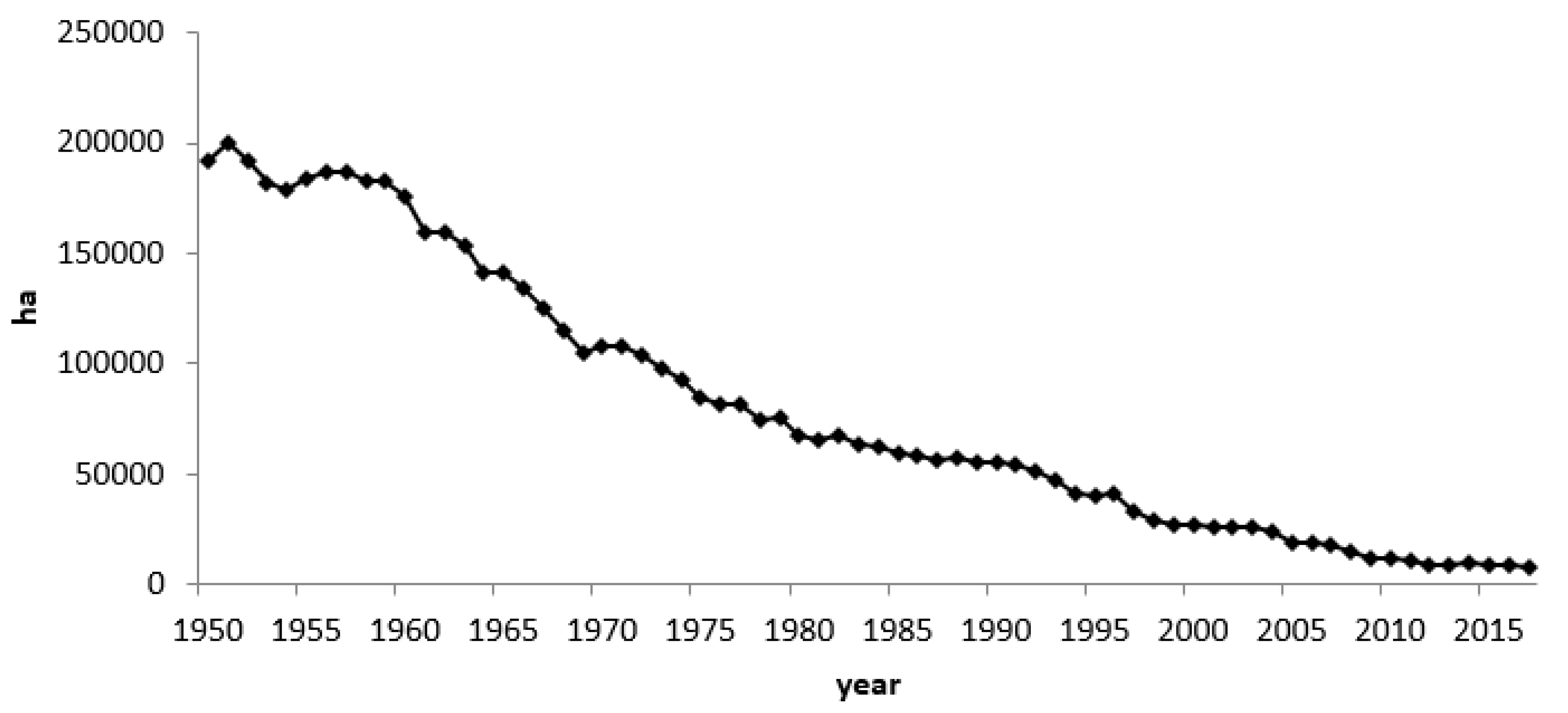
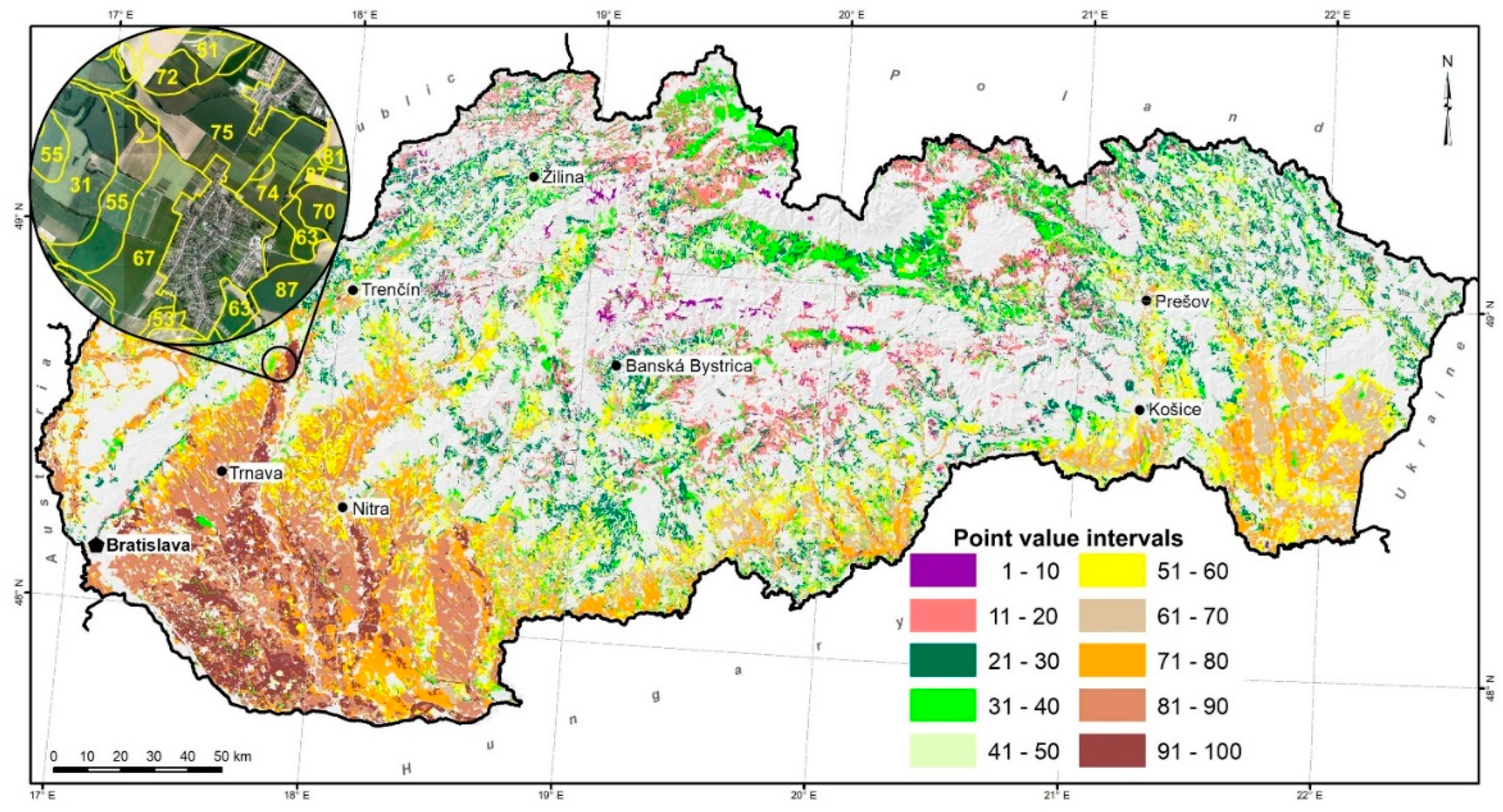
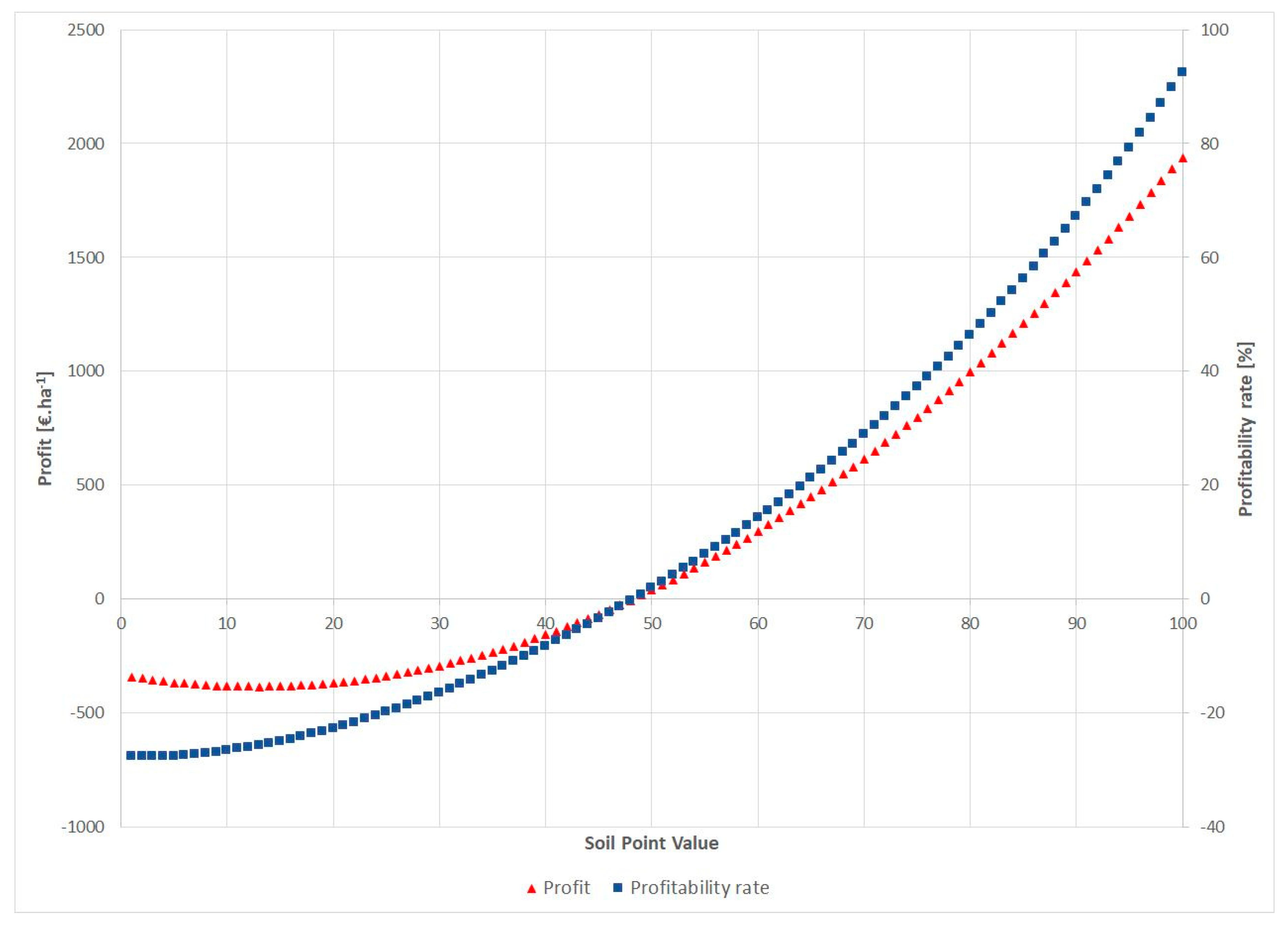
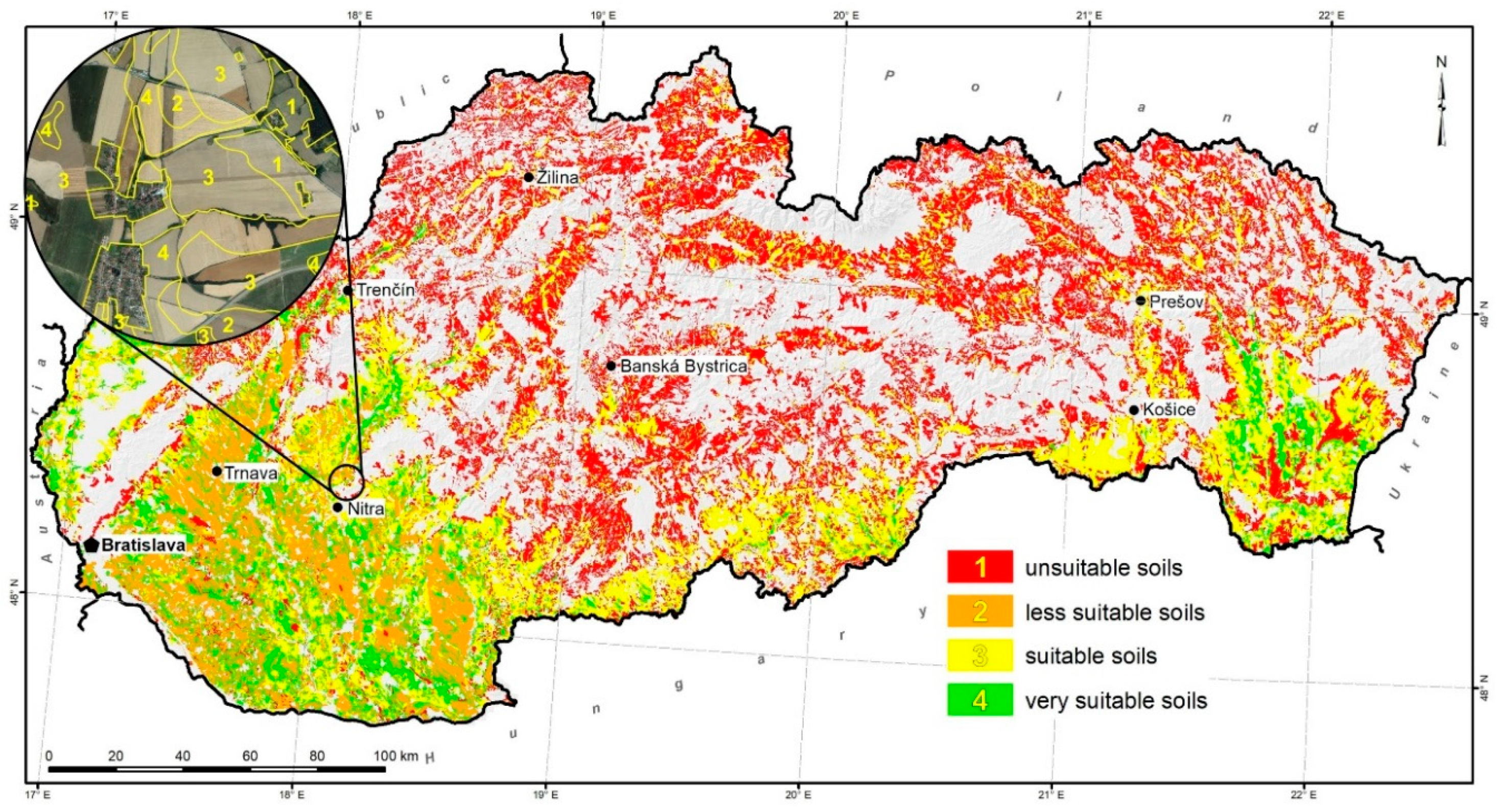
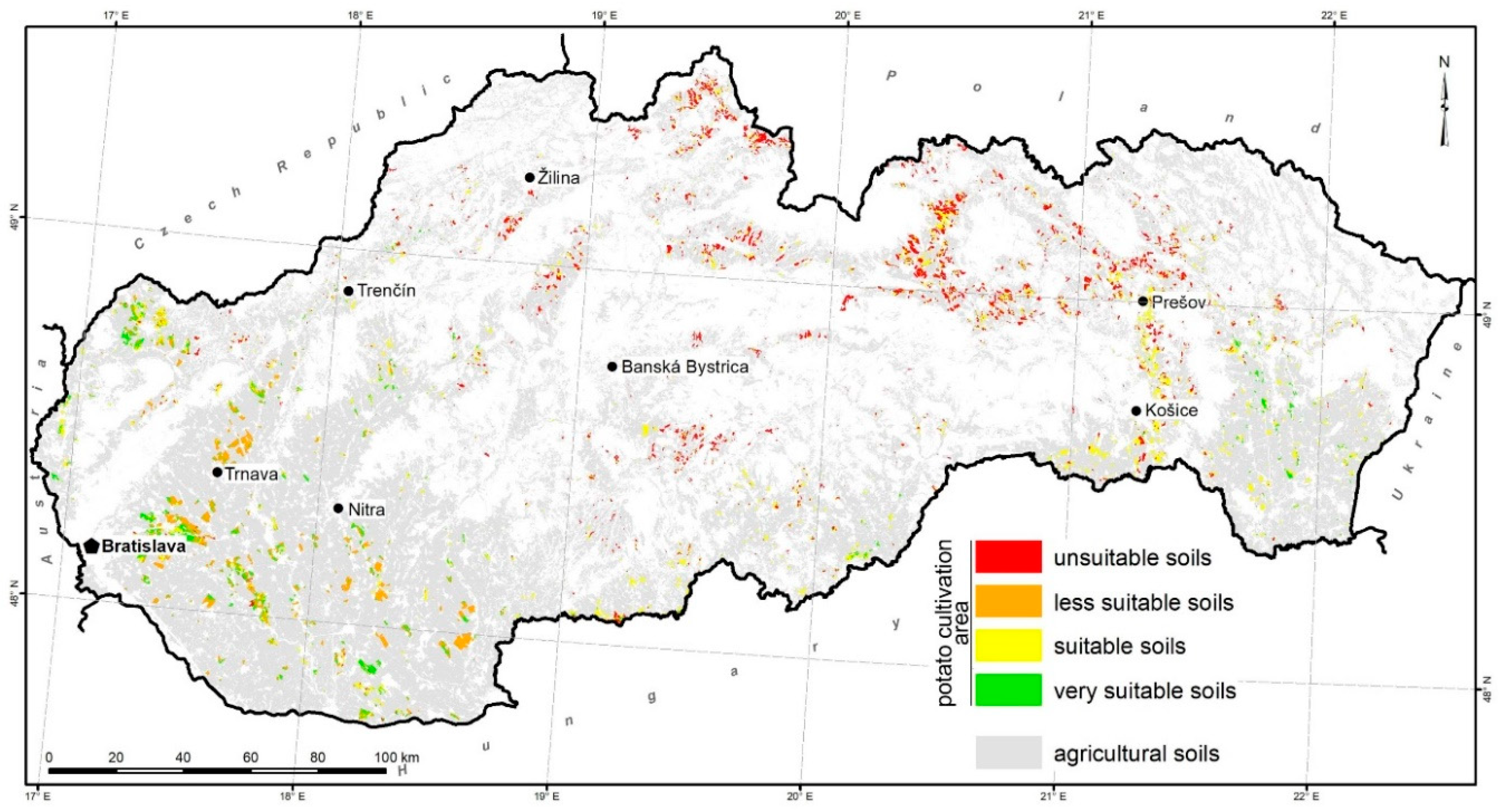
| Code | TP | Characteristics | TS > 10 °C | CMI (mm) | T Veget °C |
|---|---|---|---|---|---|
| 00 | 1.00 | very warm, very dry, flat | >3000 | 200 | 16–17 |
| 01 | 0.95 | warm, very dry, flat | 3000–2800 | 200–150 | 15–17 |
| 02 | 0.88 | sufficiently warm, dry, hilly | 2800–2500 | 150–100 | 15–16 |
| 03 | 0.95 | warm, very dry, flat, continental | 3160–2800 | 200–150 | 15–17 |
| 04 | 0.94 | warm, very dry, basin-like, continental | 3030–2800 | 200–100 | 15–16 |
| 05 | 0.87 | relatively warm, dry, basin-like, continental | 2800–2500 | 150–100 | 14–15 |
| 06 | 0.86 | relatively warm, moderately dry, highland-like, continental | 2800–2500 | 100–50 | 14–15 |
| 07 | 0.79 | moderately warm, moderately moist | 2500–2200 | 100–0 | 13–15 |
| 08 | 0.73 | moderately cold, moderately moist | 2200–2000 | 100–0 | 12–14 |
| 09 | 0.68 | cold, moist | 2000–1800 | 60–50 | 12–13 |
| 10 | 0.59 | very cold, moist | <1800 | <50 | 10–11 |
| Code | Characteristics | Point Value * |
|---|---|---|
| AL1 | the most productive arable soils | 90–100 |
| AL2 | highly productive arable soils | 81–89 |
| AL3 | very productive arable soils | 72–80 |
| AL4 | productive arable soils | 63–71 |
| AL5 | medium productive arable soils | 54–62 |
| AL6 | less productive arable soils | 45–53 |
| AL7 | low productive arable soils | 36–44 |
| AG1 | moderately productive arable soils and very productive grassland | 28–35 |
| AG2 | medium productive arable soils and medium productive grassland | 20–27 |
| AG3 | low productive arable soils and less productive grassland | <20 |
© 2020 by the authors. Licensee MDPI, Basel, Switzerland. This article is an open access article distributed under the terms and conditions of the Creative Commons Attribution (CC BY) license (http://creativecommons.org/licenses/by/4.0/).
Share and Cite
Koco, Š.; Vilček, J.; Torma, S.; Michaeli, E.; Solár, V. Optimising Potato (Solanum tuberosum L.) Cultivation by Selection of Proper Soils. Agriculture 2020, 10, 155. https://doi.org/10.3390/agriculture10050155
Koco Š, Vilček J, Torma S, Michaeli E, Solár V. Optimising Potato (Solanum tuberosum L.) Cultivation by Selection of Proper Soils. Agriculture. 2020; 10(5):155. https://doi.org/10.3390/agriculture10050155
Chicago/Turabian StyleKoco, Štefan, Jozef Vilček, Stanislav Torma, Eva Michaeli, and Vladimír Solár. 2020. "Optimising Potato (Solanum tuberosum L.) Cultivation by Selection of Proper Soils" Agriculture 10, no. 5: 155. https://doi.org/10.3390/agriculture10050155
APA StyleKoco, Š., Vilček, J., Torma, S., Michaeli, E., & Solár, V. (2020). Optimising Potato (Solanum tuberosum L.) Cultivation by Selection of Proper Soils. Agriculture, 10(5), 155. https://doi.org/10.3390/agriculture10050155




